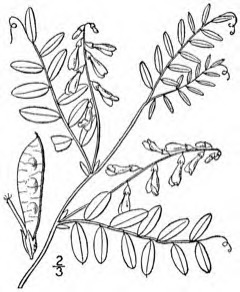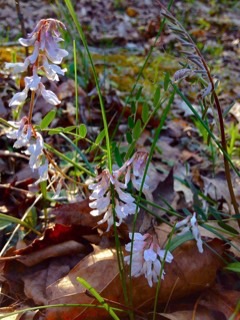 |
|
edibleplants.org |
 |
| Fritzflohrreynolds wikimedia.org |
Translate this page:
Summary
Physical Characteristics

 Vicia caroliniana is a PERENNIAL growing to 0.6 m (2ft) by 0.6 m (2ft in) at a medium rate.
Vicia caroliniana is a PERENNIAL growing to 0.6 m (2ft) by 0.6 m (2ft in) at a medium rate.
See above for USDA hardiness. It is hardy to UK zone 4. The flowers are pollinated by Insects.
It can fix Nitrogen.
It is noted for attracting wildlife.
Suitable for: light (sandy), medium (loamy) and heavy (clay) soils and prefers well-drained soil. Suitable pH: mildly acid and neutral soils. It can grow in full shade (deep woodland) semi-shade (light woodland) or no shade. It prefers moist soil.
UK Hardiness Map
US Hardiness Map
Synonyms
No synonyms are recorded for this name.
Plant Habitats
Edible Uses
References More on Edible Uses
Medicinal Uses
Plants For A Future can not take any responsibility for any adverse effects from the use of plants. Always seek advice from a professional before using a plant medicinally.
In the US, the Cherokee use Carolina wood vetch for a variety of medicinal purposes. It is used for back pains, local pains, to toughen muscles, for muscular cramps, twitching and is rubbed on stomach cramps. They also use a compound for rheumatism, for an affliction called "blacks", and it is taken for wind before a ball game (Hamel and Chiltoskey 1975 Cherokee Plants and Their Uses). An infusion is used for muscle pain, in that it is rubbed on scratches made over the location of the pain. An infusion is also taken as an emetic. It is also used internally with Pseudognaphalium obtusifolium ssp. obtusifolium for rheumatism.
References More on Medicinal Uses
The Bookshop: Edible Plant Books
Our Latest books on Perennial Plants For Food Forests and Permaculture Gardens in paperback or digital formats.

Edible Tropical Plants
Food Forest Plants for Hotter Conditions: 250+ Plants For Tropical Food Forests & Permaculture Gardens.
More

Edible Temperate Plants
Plants for Your Food Forest: 500 Plants for Temperate Food Forests & Permaculture Gardens.
More

More Books
PFAF have eight books available in paperback and digital formats. Browse the shop for more information.
Shop Now
Other Uses
Invertebrates shelter: beneficial for insects and other arthropods. Nectary: provides nectar or pollen for beneficial insects [1-2]. Host plant for Northern Cloudywing butterfly. Seeds may be eaten by songbirds. Nitrogen Fixer. Dynamic accumulator.
Special Uses
Dynamic accumulator
References More on Other Uses
Cultivation details
An attractive perennial, herbaceous vine generally sprawling, occasionally climbing stems with tendrillate leaf tips. Light: Full sun (6 or more hours of direct sunlight a day) to partial shade (direct sunlight only part of the day, 2-6 hours). There is some suggestion that it can take deep shade but we have been unable to confirm this. Soil Drainage: moist and well-drained, occasionally Dry. Flower Color: Pink, White. Flower Bloom Time: Spring. Flower Description: Light pinkish white, pea-like flowers appear in spring. This plant has an extreme flammability rating. For polyculture design as well as the above-ground architecture (form - tree, shrub etc. and size shown above) information on the habit and root pattern is also useful and given here if available. Herbaceous. Growth habit is a single or multiple shooting vine from a crown [1-2].
References Carbon Farming Information and Carbon Sequestration Information
Temperature Converter
Type a value in the Celsius field to convert the value to Fahrenheit:
Fahrenheit:
The PFAF Bookshop
Plants For A Future have a number of books available in paperback and digital form. Book titles include Edible Plants, Edible Perennials, Edible Trees,Edible Shrubs, Woodland Gardening, and Temperate Food Forest Plants. Our new book is Food Forest Plants For Hotter Conditions (Tropical and Sub-Tropical).
Shop Now
Plant Propagation
Seed.
Other Names
If available other names are mentioned here
Wood Vetch, Carolina Vetch
Native Range
NORTHERN AMERICA: Canada (Ontario (south)), United States (Indiana, Michigan, Ohio, Pennsylvania, West Virginia, Minnesota, Missouri (south), Illinois, Wisconsin, Alabama, Georgia, Kentucky, Louisiana, Maryland, North Carolina, South Carolina, Virginia, Mississippi, Tennessee, Texas (east))
Weed Potential
Right plant wrong place. We are currently updating this section.
Please note that a plant may be invasive in one area but may not in your area so it's worth checking.
None Known
Conservation Status
IUCN Red List of Threatened Plants Status : Not Listed.

| Related Plants
|
| Latin Name | Common Name | Habit | Height | Hardiness | Growth | Soil | Shade | Moisture | Edible | Medicinal | Other |
| Artemisia ludoviciana | White Sage, Louisiana Sage, Prairie Sage, Western Mugwort | Perennial | 1.0 |
3-9
| M | LM | SN | DM | 2 | 2 | 2 |
| Artemisia ludoviciana gnaphalodes | White Sage | Perennial | 1.0 |
4-8
| | LM | SN | DM | 0 | 2 | 1 |
| Avena ludoviciana | Oats | Annual | 0.0 |
-
| | LMH | N | DM | 2 | 0 | 2 |
| Lactuca ludoviciana | Western Wild Lettuce, Biannual lettuce | Biennial | 1.2 |
0-0
| | LM | SN | M | 2 | 2 | |
| Orobanche ludoviciana | Broomrape, Louisiana broomrape | Perennial | 1.5 |
0-0
| | LMH | FSN | M | 1 | 1 | 0 |
| Vicia americana | American Vetch, Mat vetch | Perennial | 1.0 |
4-7
| | LMH | SN | M | 2 | 1 | 4 |
| Vicia amoena | | Perennial | 1.0 |
-
| | LMH | SN | M | 1 | 0 | |
| Vicia amurensis | | Perennial | 1.5 |
-
| | LMH | SN | M | 1 | 0 | |
| Vicia articulata | One-Flower Vetch | Annual | 0.6 |
-
| | LMH | SN | M | 1 | 0 | 3 |
| Vicia benghalensis | Purple Vetch | Annual/Perennial | 0.6 |
-
| F | LMH | SN | M | 0 | 0 | 3 |
| Vicia cracca | Tufted Vetch, Bird vetch, Cow vetch | Perennial Climber | 1.8 |
4-8
| | LMH | SN | M | 1 | 1 | 3 |
| Vicia ervilia | Bitter Vetch | Annual | 0.6 |
-
| | LMH | SN | M | 1 | 0 | |
| Vicia faba equina | Horsebean | Annual | 1.0 |
4-8
| F | LMH | SN | M | 3 | 0 | 3 |
| Vicia faba major | Broad Bean, Fava Bean | Annual | 1.0 |
4-10
| F | LMH | SN | M | 4 | 1 | 3 |
| Vicia faba minuta | Tick Bean | Annual | 1.0 |
4-8
| F | LMH | SN | M | 3 | 0 | 3 |
| Vicia gigantea | Giant Vetch | Perennial | 1.0 |
4-8
| | LMH | SN | M | 2 | 1 | 3 |
| Vicia grandiflora kitaibeliana | large yellow vetch | Annual | 0.0 |
-
| | LMH | SN | M | 2 | 0 | |
| Vicia heptajuga | | Perennial | 0.0 |
-
| | LMH | SN | M | 1 | 0 | |
| Vicia hirsuta | Hairy Tare, Tiny vetch | Annual | 0.5 |
4-9
| | LMH | SN | M | 2 | 0 | 3 |
| Vicia hirticalycina | | Perennial | 0.0 |
-
| | LMH | SN | M | 1 | 0 | |
| Vicia japonica | | Perennial | 1.5 |
-
| | LMH | SN | M | 1 | 0 | |
| Vicia monantha | Hard Vetch, Barn vetch | Annual | 0.0 |
0-0
| | LMH | SN | M | 2 | 0 | 3 |
| Vicia narbonensis | French Vetch, Purple broad vetch | Annual | 1.0 |
0-0
| | LMH | SN | M | 2 | 0 | |
| Vicia nipponica | | Perennial | 0.8 |
-
| | LMH | SN | M | 1 | 0 | |
| Vicia noeana | | Annual | 0.6 |
-
| | LMH | SN | M | 1 | 0 | |
| Vicia pisiformis | Pea Vetch, Pale-flower vetch | Perennial | 1.8 |
0-0
| | LMH | SN | M | 1 | 0 | |
| Vicia pseudo-orobus | | Perennial | 1.5 |
-
| | LMH | SN | DM | 1 | 0 | |
| Vicia sativa | Winter Tares, Garden vetch, Subterranean vetch | Annual Climber | 1.2 |
4-8
| F | LMH | SN | M | 3 | 0 | 3 |
| Vicia sativa leucosperma | Winter Tares | Annual Climber | 1.2 |
4-8
| F | LMH | SN | M | 3 | 0 | 3 |
|
|
Growth: S = slow M = medium F = fast. Soil: L = light (sandy) M = medium H = heavy (clay). pH: A = acid N = neutral B = basic (alkaline). Shade: F = full shade S = semi-shade N = no shade. Moisture: D = dry M = Moist We = wet Wa = water.
Now available:
Food Forest Plants for Mediterranean Conditions
350+ Perennial Plants For Mediterranean and Drier Food Forests and Permaculture Gardens.
[Paperback and eBook]
This is the third in Plants For A Future's series of plant guides for food forests tailored to
specific climate zones. Following volumes on temperate and tropical ecosystems, this book focuses
on species suited to Mediterranean conditions—regions with hot, dry summers and cool, wet winters,
often facing the added challenge of climate change.
Read More
Expert comment
Author
Walter
Botanical References
Links / References
For a list of references used on this page please go here
Readers comment
| Add a comment |
|
If you have important information about this plant that may help other users please add a comment or link below. Only comments or links that are felt to be directly relevant to a plant will be included. If you think a comment/link or information contained on this page is inaccurate or misleading we would welcome your feedback at [email protected]. If you have questions about a plant please use the Forum on this website as we do not have the resources to answer questions ourselves.
* Please note: the comments by website users are not necessarily those held by PFAF and may give misleading or inaccurate information.
To leave a comment please Register or login here All comments need to be approved so will not appear immediately.
|
Subject : Vicia caroliniana
|
|
|
|